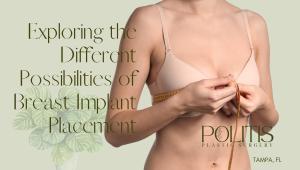 As a woman, your breasts are an integral part of your overall appearance. And whether they are small or large, perky or not, their appearance can cause a feeling that impacts all areas of your life.
As a woman, your breasts are an integral part of your overall appearance. And whether they are small or large, perky or not, their appearance can cause a feeling that impacts all areas of your life.
Plus, the psychological fallout that follows when you’re dissatisfied with the way your breasts look can be devastating for some women, including a nose dive in confidence, loss of self-esteem and feeling unattractive.
Fortunately, through breast augmentation using breast implants you can:
- Make your breasts larger, fuller, perkier, and higher on your chest, achieving an enhanced, more youthful appearance.
- Correct asymmetry and eliminate embarrassing difference in size between your breasts.
- Enjoy psychological and lifestyle benefits, including a renewed freedom in shopping for clothes, enhanced capacity to embrace new opportunities and engage in relationships, and an overall feeling of being more attractive, more confident, sexier and happier overall.
How long do breast implants last?
While breast implants can help restore feminine curves and boost self-image, they don’t last a lifetime.
Generally, the lifespan of breast implants—whether saline or silicone—is 10-20 years after initial augmentation surgery. But since every patient heals and responds differently to surgery, the actual life of your implants would depend on your body and how well you take care of them.
Before surgery, your plastic surgeon will explain to you how to care for the implants and the necessary check ups you should undergo to ensure they last longer. Nonetheless, no matter how well you care for them, you should still understand that the implants will need to be removed or replaced at some point.
What are the common reasons for implant removal or replacement?
- Capsular contracture
Sometimes, no matter how skilled and experienced your plastic surgeon is, complications still arise after surgery due to the unique healing process that every patient undergoes. Capsular contracture—the development of a thick and hard scar tissue around one or both implants—is one such potential complication.
When you have unusually hard capsules of scar tissue around the implants after surgery, you will have aesthetic problems and, in extreme cases, pain in the breasts. So in rare instances you may need to undergo revision surgery to remove or replace the implants, particularly if the scar tissue causes tightness, pain, tenderness and changes in breast size and shape.
- Implant rippling
Breast implant rippling refers to formation of wrinkles and folds around an implant. When the folds and wrinkles are extreme, they become noticeable on the skin and may require revision surgery to correct. Causes of rippling include poor tissue coverage of the implants, scar capsules that are too loose, under-filled or overfilled saline implants, or round-shaped implants.
Rippling may arise after breast reconstruction with saline or silicone implants and tends to develop on the outer perimeter (side, bottom, near cleavage) of the reconstructed breasts. It is also associated more with saline-filled implants than with silicone implants.
When the rippling is visible on the skin, your surgeon may recommend revision surgery. The revision options your surgeon may consider include an operation to replace an undersized implant, tighten the scar capsule, replace saline implant with silicone implant, reposition the implant, change shape of the implant, or remove under-filled or over-filled implants.
- Saline or silicone implant rupture
New saline and silicone implants rarely rupture.
But in older models it can sometimes happen so in those instances saline implants may deflate quickly like balloons. The saline solution then leaks out through the tear and is absorbed harmlessly into the body. In turn, breasts lose size and shape, and look different. Though the risk of saline rapture is rare, it increases by 1-percent every year after the surgery.
Silicone gel-filled implants have a thick silicone gel inside that stays either inside the implant or surrounding tissue even after implant rupture. So it is difficult to notice when a silicone implant ruptures; except that the breasts show uneven appearance and have changes in breast sensation, such as swelling, tingling, numbness, or burning.
When a saline or silicone gel-filled implant has ruptured, your plastic surgeon may recommend surgical removal or replacement. In some cases, your surgeon will also remove the capsule of scar tissue surrounding the implant or just remove the capsule by making small incisions. Typically, implants in both breasts are removed even if only one has ruptured, then replaced during the same surgery.
- Positional change
Implant malposition is one of the common reasons for revisionary breast surgery. Generally, breast implant malposition is caused by the implant pocket being too large for a given implant, resulting in the implant not being centered inside the breast.
To correct implant malposition, your surgeon can opt to perform revision surgery to replace the implant, and then follow that with a precise suturing of the pockets from the inside of the breasts to have the implants properly fitted. Plus, the doctor may switch the implant pocket location or add a lifting procedure to create the desired breast appearance.
- Personal desire to change breast appearance
Tastes and preferences are never constant and tend to change with time. So some years after your breast augmentation, you may feel that you need to change the appearance of your breasts or to remove them entirely.
Your plastic surgeon will listen to you, carefully assess your goals and expectations, and guide you on making an informed decision. Then, the surgeon may recommend that you undergo revision surgery to replace the implants with larger or smaller implants, or to remove them entirely based on your lifestyle and aesthetic priorities.
What should you expect during breast implant removal?
Since your implant can be removed or replaced by any qualified plastic surgeon, you won’t necessarily have to go to the surgeon who did the first surgery. During your consultation session with the surgeon, the implant will be evaluated and your surgical options explored.
Depending on the problem with the implant and on your preferences, the surgeon will:
- Do implant removal alone.
- Remove the implant and perform a breast lift.
- Remove lumpy or hardened tissue
Since implant removal can lead to cosmetic abnormalities, such as sagging, dimpling, deflation, or asymmetry, your surgeon may recommend replacing the removed implants with those of a different shape or size.
What should you expect from breast implant replacement?
Implant replacement is the procedure in which your doctor replaces your problematic implants for newer implants. You may stick to the same type, size, and shape or go with different implants altogether.
The replacement can be combined with a breast lift or with scar tissue removal. But usually, the cost of implant replacement is higher than that of implant removal as you will need to pay for the initial removal, replacement implants, and any other related procedures.
How do you care for your implants to make them last longer?
One of the best steps to take to ensure your implants last longer is to consider carefully and choose the right size and shape the first time. That’s because most cases of implant removal or replacement arise from unhappiness with implant size and shape.
So pick breast implants of the size and shape you feel you can live with for 10-20 years—remember your tastes will change over the course of your lifetime.
Speak with your plastic surgeon about your cosmetic goals and implant preferences, and request broad advice and recommendations. By being open with your plastic surgeon and following recommendations, you will make a better choice.
Because implant removal or replacement may be necessary due to local complications, such as ruptures, deflations, wear and tear, or surgical error, you need to choose a skilled, experienced surgeon who performs the procedures regularly. A surgeon with experience in the removal or replacement is ideal.
At Politis Plastic Surgery, we make sure that you are aware of the lifespan of implants and that they aren’t guaranteed to last a lifetime. In fact, during your consultation, our board-certified surgeon will explain to you what to expect from different types of implants and help you to choose the right implant.
For more information on breast augmentation, breast reduction, breast lift, and other plastic surgery procedures, visit the site “Politis Plastic Surgery.”



 You’re at a crossroads. You’ve decided to undergo
You’re at a crossroads. You’ve decided to undergo 

 Getting ready to undergo
Getting ready to undergo 

 Deciding on the
Deciding on the 

 Breast augmentation
Breast augmentation
 As a woman, your breasts are an integral part of your overall appearance. And whether they are small or large, perky or not, their appearance can cause a feeling that impacts all areas of your life.
As a woman, your breasts are an integral part of your overall appearance. And whether they are small or large, perky or not, their appearance can cause a feeling that impacts all areas of your life. 
